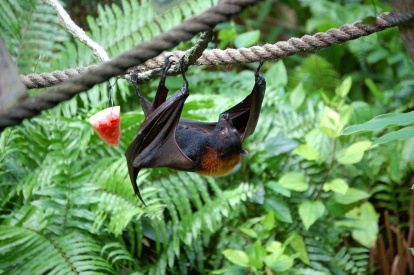The following is written by Amy Tseng from PublicHealthInsider.com:
Bats have an unfortunate reputation. A small, unscientific survey of our staff said they associate bats with “vampires,” “Mitzvah,” “Michael Keaton,” and “Nelson Cruz.”
Clearly, we needed to learn more. So we sat down with our in-house expert, Public Health Veterinarian Beth Lipton, who reminded us that bats aren’t all bad, but you really shouldn’t touch them.
Let’s start with some myth-busting.
True or false: Bats are evil and suck our blood.
Bats are no more evil than any other animal, and our Washington bats do not suck blood. They actually eat a large amount of night-flying insects, including moths, beetles, mosquitoes, termites and flies. Bats are actually very beneficial to our environment and ecology because they help preserve the natural balance of the insect population – particularly mosquitoes.
True or false: Bats are blind.
Bats are not blind and do not become entangled in peoples’ hair. If a bat flies near or toward your head, it is probably hunting insects that have been attracted by your body heat.
Where will I most likely encounter a bat?
Your home. If a bat flies into your house, open the windows and doors to allow the bat to fly out on its own. Make sure to put your pets in another room with the doors closed. Keep common entry points to your home closed to avoid letting a bat inside. Refer to the figure for tips on entryways bats use to enter homes.
What are normal or abnormal bat behaviors?
Bats do not usually come into contact with people since they are active at night. If you do see a bat during the day, and it’s acting strangely – struggling to fly or lying on the ground – the bat could potentially be infected with rabies. Leave that bat alone! Bats should be captured only if there has been direct contact with a person or pet or if the bat was found in the room of someone who might have been exposed. Never handle a bat with your bare hands. Once a bat is captured, call Public Health, and we will test it for rabies infection.
What is rabies and how is it transmitted?
Rabies is a severe viral disease of the central nervous system transmitted through an infected animal’s saliva and is almost always fatal once symptoms begin. In Washington State, most cases of rabies are found in bats.
How likely is it for humans or our pets to get rabies?
There is a very rare chance for humans to get rabies as Public Health carefully monitors and follows up with potential rabies cases. Typically, there are about one to three cases in the U.S. a year and the majority of these cases are a result of the bat rabies virus. Last year, the Washington State Public Health Laboratory tested 276 bats and only 15 (5%) were positive for rabies. More than 150 other animals were also tested for rabies, and all results were negative. All that said, cats love catching bats, so remember to keep your cats and dogs up to date with their rabies vaccinations!


